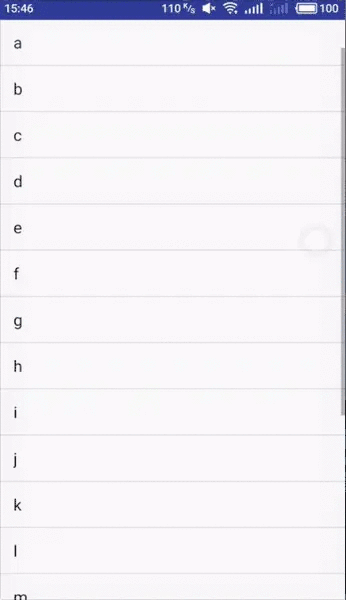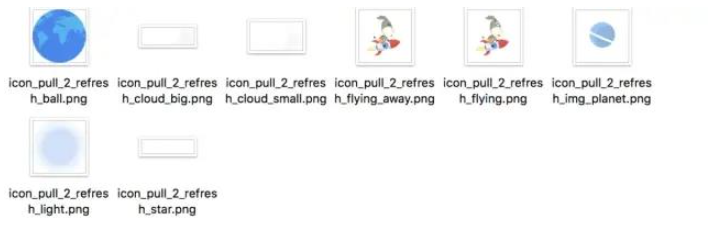这篇文章主要介绍“如何用Android实现下拉刷新效果”的相关知识,小编通过实际案例向大家展示操作过程,操作方法简单快捷,实用性强,希望这篇“如何用Android实现下拉刷新效果”文章能帮助大家解决问题。
效果:

可以将动画分解成:
睁眼毛驴绕着中心地球旋转,并且在到达地球中心时,切换为闭眼毛驴,最后发射出去
地球自我旋转,随着下拉而缓缓上升,达到半径距离后停止上升
一颗上下来回移动的卫星
(1)下载赶集app,然后将其后缀名改为zip解压获取我们需要的资源图片:

(2) 我们先实现卫星的上下移动
核心代码:
@Override
protected void onDraw(Canvas canvas) {
super.onDraw(canvas);
Matrix matrixPlanet = new Matrix();
matrixPlanet.setScale(0.4f, 0.4f);
matrixPlanet.postTranslate(locationX / 2 * 3, locationY /4);
matrixPlanet.postTranslate(0, upDateY);
canvas.drawBitmap(flyingPlanet,matrixPlanet,null);
}
public void startTranslatePlanet(int duration){
ValueAnimator valueAnimator = new ValueAnimator();
valueAnimator.setFloatValues(-50.0f, 50.0f);
valueAnimator.setDuration(duration);
valueAnimator.addUpdateListener(new ValueAnimator.AnimatorUpdateListener() {
@Override
public void onAnimationUpdate(ValueAnimator animation) {
upDateY = (float) animation.getAnimatedValue();
invalidate();
}
});
valueAnimator.setRepeatCount(ValueAnimator.INFINITE);
valueAnimator.setRepeatMode(ValueAnimator.REVERSE);
valueAnimator.setInterpolator(new LinearInterpolator());
valueAnimator.start();
}思想:使用Matrix来设置图形变换,调用setScale()设置Bitmap缩放大小,然后调用postTranslate()将Bitmap平移到卫星的初始位置。最后使用ValueAnimator计算卫星上下移动的距离,再调用postTranslate()即可。
(3)地球自我旋转,随着下拉而缓缓上升,达到半径距离后停止上升。
核心代码:
@Override
protected void onDraw(Canvas canvas) {
super.onDraw(canvas);
Matrix matrixBall = new Matrix();
matrixBall.setScale(0.2f, 0.2f);
if ((locationY + upDateY) > (locationY - flyingBall_Height / 2)) {
matrixBall.postTranslate(locationX - flyingBall_Width / 2, locationY + upDateY);
matrixBall.postRotate(degreeBall, locationX, (locationY +upDateY + flyingBall_Height /2) );
}
else {
matrixBall.postTranslate(locationX - flyingBall_Width / 2, locationY - flyingBall_Height / 2);
matrixBall.postRotate(degreeBall, locationX, locationY);
}
canvas.drawBitmap(flyingBall, matrixBall, null);
canvas.drawBitmap(cloudBig , null , rectfCloudBig , null);
canvas.drawBitmap(cloudSmall , null , rectfCloudSmall ,null);
}
public void startBallAnim(long duration) {
ValueAnimator valueAnimator = new ValueAnimator();
valueAnimator.setFloatValues(0.0f, 360.0f);
valueAnimator.setDuration(duration);
valueAnimator.addUpdateListener(new ValueAnimator.AnimatorUpdateListener() {
@Override
public void onAnimationUpdate(ValueAnimator animation) {
degreeBall = (float) animation.getAnimatedValue();
invalidate();
}
});
valueAnimator.setRepeatCount(ValueAnimator.INFINITE);
valueAnimator.setInterpolator(new LinearInterpolator());
valueAnimator.start();
}
public void UpBall(float offsetY){
if (upDateY!=offsetY) {
upDateY = offsetY;
invalidate();
}
}
public void accelerateBall(long duration) {
clearAnimation();
startBallAnim(duration);
}思想:同样使用Matrix,先设置缩放大小。调用
matrixBall.postTranslate(locationX - flyingBall_Width / 2, locationY + upDateY);将bitmap隐藏在view可视范围的下方,然后通过下拉刷新列表获取下拉刷新的Y坐标的改变量,调用postTranslate()上移改变量大小的距离即可。自转动画的实现,就是调用postRotate()方法 使用ValueAnimator 获取改变量。因为地球是上升的,所以我们需要动态的设置旋转的中心。
matrixBall.postRotate(degreeBall, locationX, (locationY +upDateY + flyingBall_Height /2) );只需要改变减去下拉刷新列表获取下拉刷新的Y坐标的改变量就可以了。
(3) 睁眼毛驴绕着中心地球旋转,并且在到达地球中心时,切换为闭眼毛驴,最后发射出去
核心代码:
@Override
protected void onDraw(Canvas canvas) {
super.onDraw(canvas);
Matrix matrix = new Matrix();
matrix.setScale(0.3f, 0.3f);
matrix.postTranslate(pointDonkey.getDx(), pointDonkey.getDy());
matrix.postRotate(degree, locationX, locationY + flyingBall_Width / 2);
matrix.postTranslate(0 , upDateY);
canvas.drawBitmap(flyingDonkey, matrix, null);
}思想:与上面一样,先调用setScale()设置缩放大小,在进行平移旋转操作的时候。
matrix.postRotate(degree, locationX, locationY + flyingBall_Width / 2);
matrix.postTranslate(0 , upDateY);我们先绕着还没有移动的地球旋转,然后调用postTranslate()将其与地球一起上升。
关于“如何用Android实现下拉刷新效果”的内容就介绍到这里了,感谢大家的阅读。如果想了解更多行业相关的知识,可以关注亿速云行业资讯频道,小编每天都会为大家更新不同的知识点。
亿速云「云服务器」,即开即用、新一代英特尔至强铂金CPU、三副本存储NVMe SSD云盘,价格低至29元/月。点击查看>>
免责声明:本站发布的内容(图片、视频和文字)以原创、转载和分享为主,文章观点不代表本网站立场,如果涉及侵权请联系站长邮箱:is@yisu.com进行举报,并提供相关证据,一经查实,将立刻删除涉嫌侵权内容。
原文链接:https://www.xuebuyuan.com/3269865.html